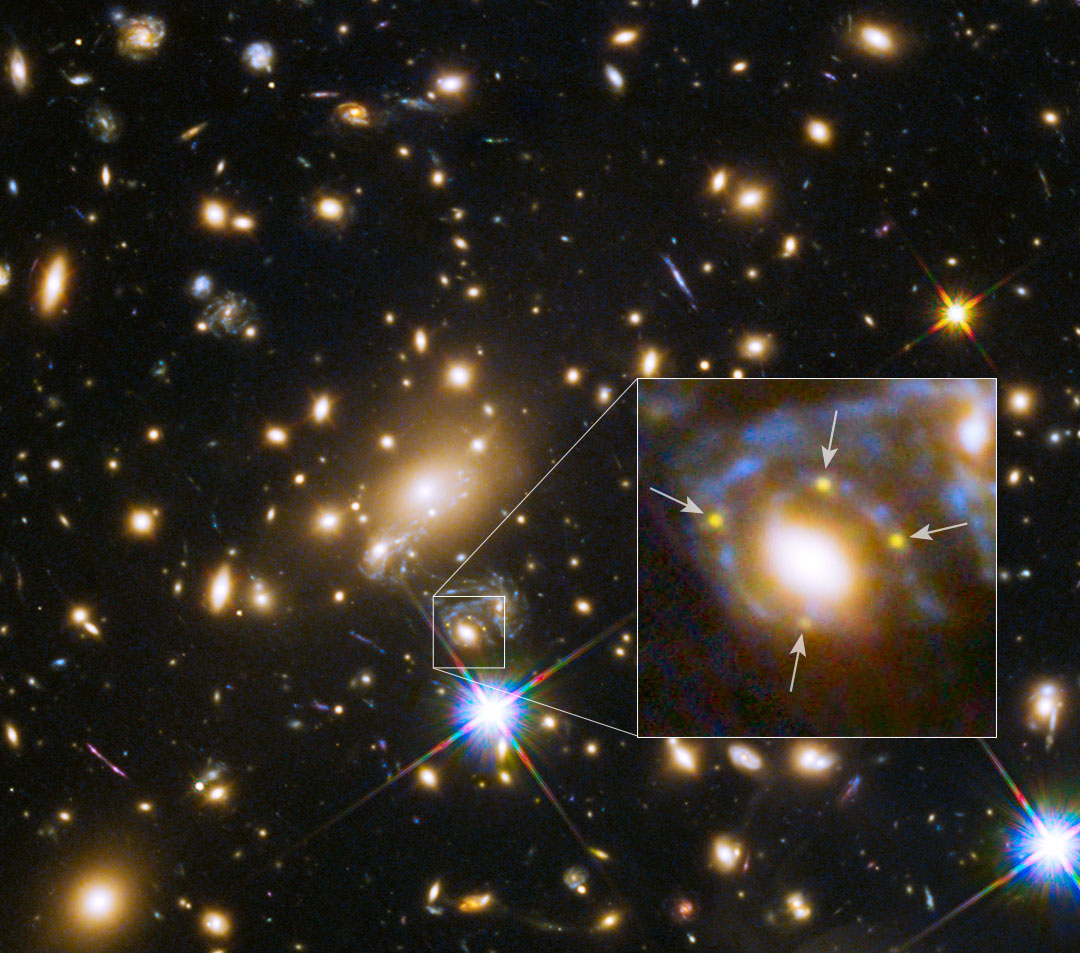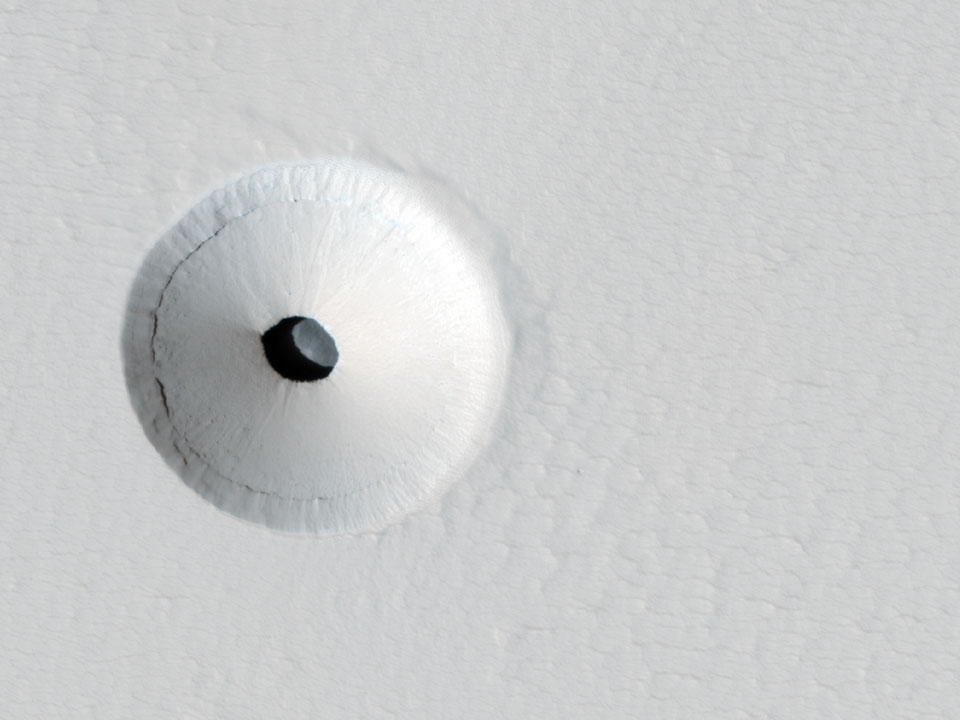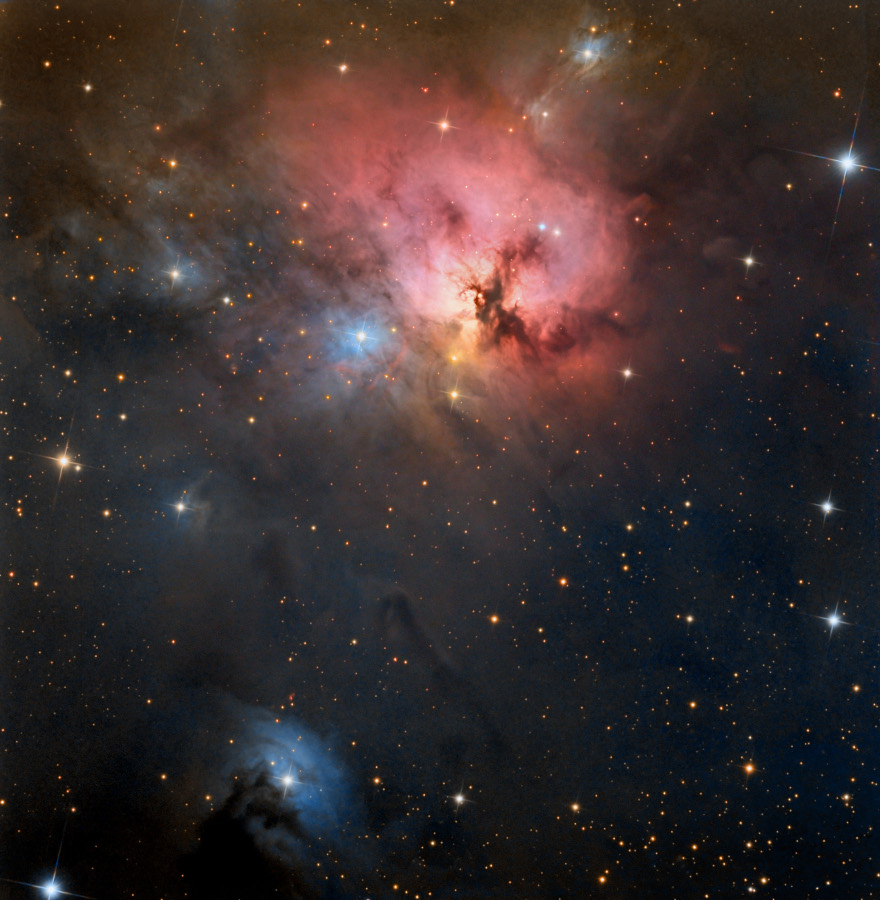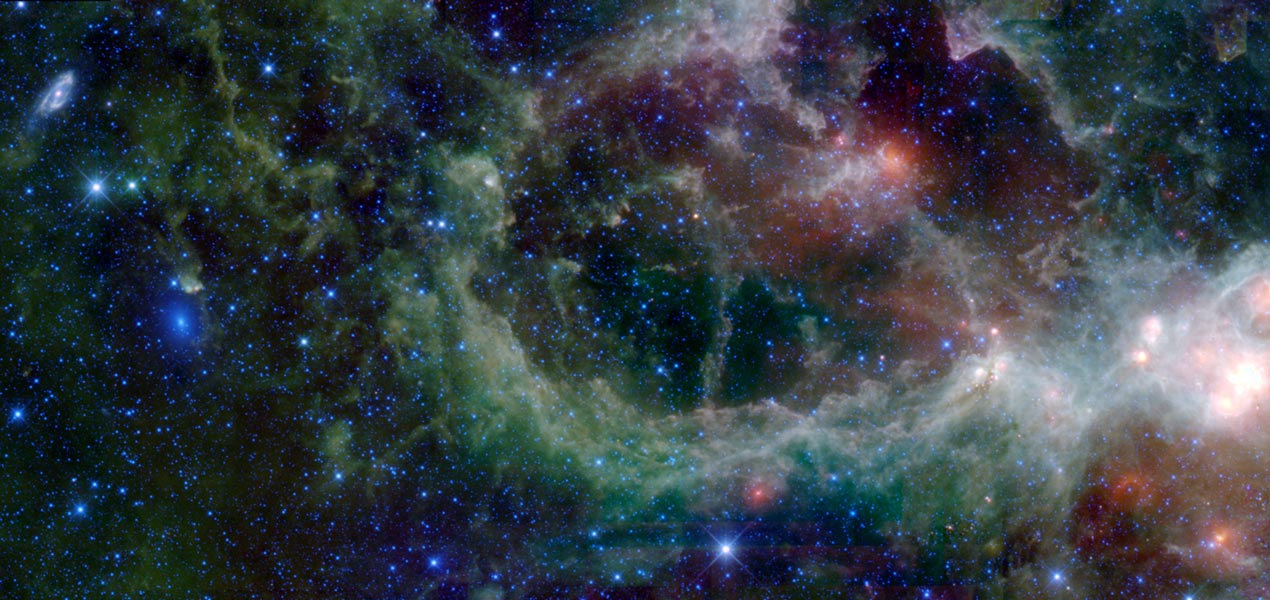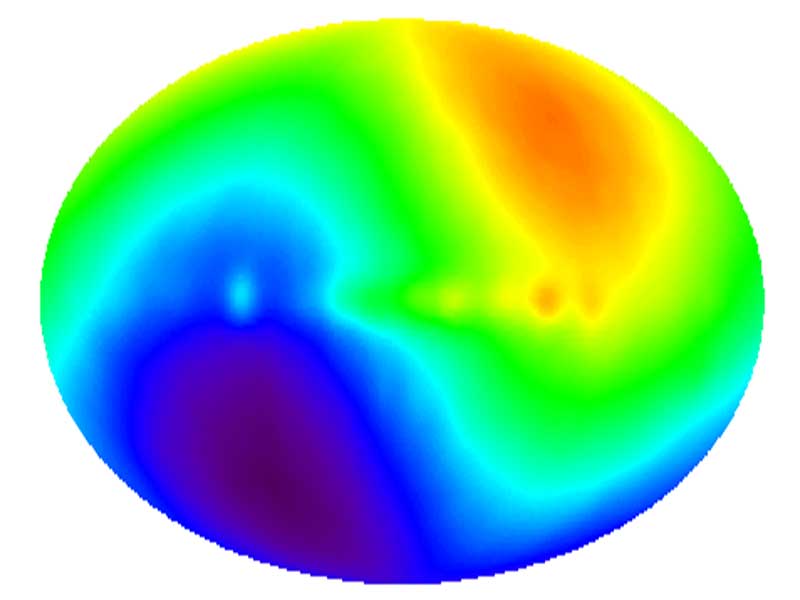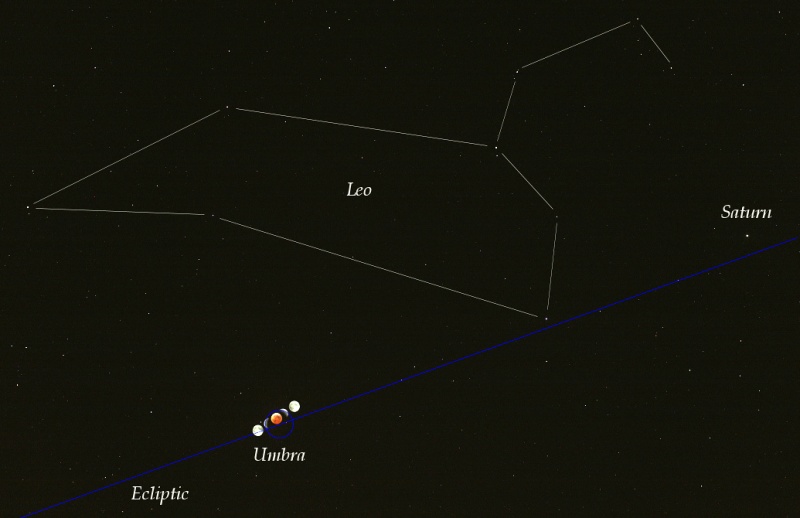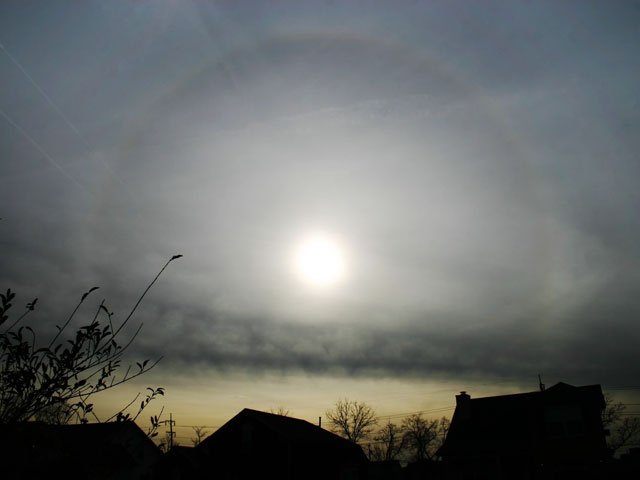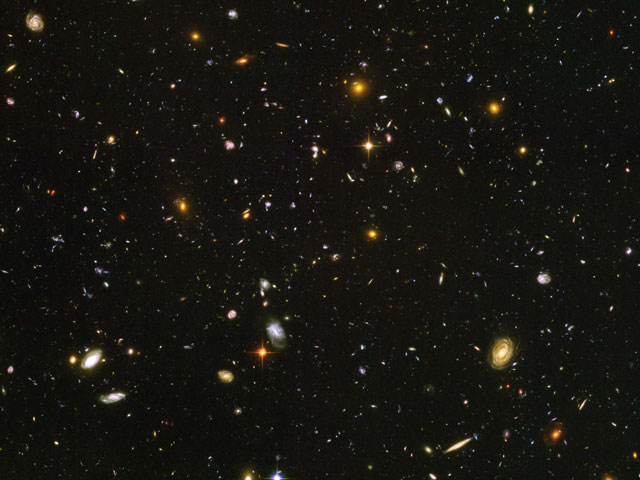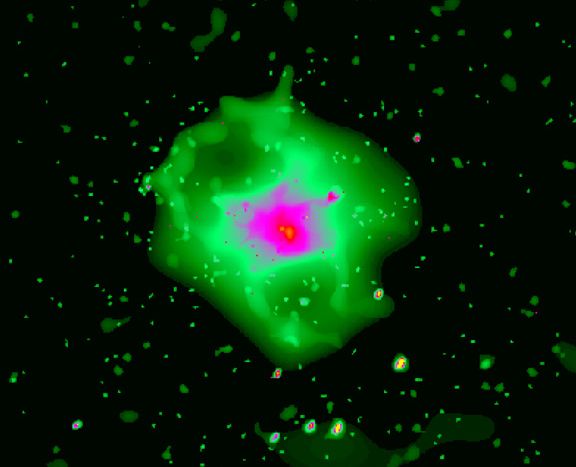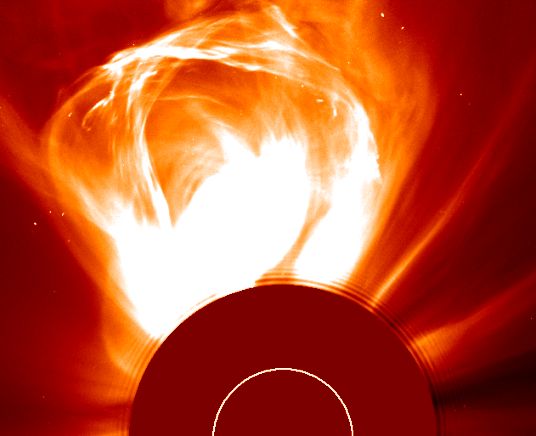| << Previous | Index | Next >> |
2015
2014 What created this unusual hole in Mars? The hole was discovered by chance in 2011 on images of the dusty slopes of Mars' Pavonis Mons volcano taken by the HiRISE instrument aboard the robotic Mars Reconnaissance Orbiter currently circling Mars. The hole appears to be an opening to an underground cavern, partly illuminated on the image right. Analysis of this and follow-up images revealed the opening to be about 35 meters across, while the interior shadow angle indicates that the underlying cavern is roughly 20 meters deep. Why there is a circular crater surrounding this hole remains a topic of speculation, as is the full extent of the underlying cavern. Holes such as this are of particular interest because their interior caves are relatively protected from the harsh surface of Mars, making them relatively good candidates to contain Martian life. These pits are therefore prime targets for possible future spacecraft, robots, and even human interplanetary explorers.
2013 Sweeping quickly through southern skies on March 5, Comet PanSTARRS (C/2011 L4) follows the Sun toward the western horizon in this twilight scene. In the foreground is Australia's CSIRO Parkes Radio Telescope, a 64 meter wide steerable dish that is no stranger to the space age exploration of comets. In March of 1986 the Parkes dish tracked ESA's Giotto spacecraft as it flew by Comet Halley and received the first ever closeup images of Halley's nucleus. At naked-eye visibility, Comet PanSTARRS made its closest approach to planet Earth on March 5. Its closest approach to the Sun will be on March 10. Heading north, PanSTARRS now begins a much anticipated appearance low in the northern hemisphere's western skies after sunset. On March 12, look for the comet hugging the western horizon near a young crescent Moon.
2012 Colorful NGC 1579 resembles the better known Trifid Nebula, but lies much farther north in planet Earth's sky, in the heroic constellation Perseus. About 2,100 light-years away and 3 light-years across, NGC 1579 is, like the Trifid, a study in contrasting blue and red colors, with dark dust lanes prominent in the nebula's central regions. In both, dust reflects starlight to produce beautiful blue reflection nebulae. But unlike the Trifid, in NGC 1579 the reddish glow is not emission from clouds of glowing hydrogen gas excited by ultraviolet light from a nearby hot star. Instead, the dust in NGC 1579 drastically diminishes, reddens, and scatters the light from an embedded, extremely young, massive star, itself a strong emitter of the characteristic red hydrogen alpha light.
2011 The developing International Space Station (ISS) has changed its appearance again. In a recently completed rendezvous, the Space Shuttle orbiter Discovery, in its final flight, visited the ISS and added components that included the Leonardo Multi Purpose Logistics Module. The ISS and many of its modules and expansive solar panels are visible in the above picture taken by the Discovery Crew after leaving the ISS to return to Earth. The world's foremost space outpost can be seen developing over the past several years by comparing the above image to other past images. Also visible above are many different types of modules and supply ships. Construction began on the ISS in 1998.
2010 The two galaxies on the far left were unknown until 1968. Although they would have appeared as two of the brighter galaxies on the night sky, the opaque dust of the central band of our Milky Way Galaxy had obscured them from being seen in visible light. The above image in infrared light taken by the recently launched Wide-Field Infrared Survey Explorer (WISE), however, finds these galaxies in great detail far behind -- but seemingly next to -- the photogenic Heart nebula (IC 1805). The spiral galaxy near the top is the easiest to spot and is known as Maffei 2. Just below and to its right is fuzzy-looking Maffei 1, the closest giant elliptical galaxy to Earth. The above false-colored image spans three full moons from top to bottom. The Maffei galaxies each span about 15,000 light years across and lie about 10 million light years away toward the constellation of the Queen of Ethiopia (Cassiopeia). On the image right, stars, gaseous filaments, and warm dust highlight a detailed infrared view of the Heart nebula.
2009 Streaking skyward, a Delta II rocket carries NASA's Kepler spacecraft aloft into the clear night of March 6. The dramatic scene was recorded in a time exposure from the crowded pier in Jetty Park at the northern end of Cocoa Beach, Florida, about 3 miles from the Cape Canaveral launch site. Kepler's mission is to search for Earth-like planets orbiting in the habitable zone of other stars. A planet orbiting within a star's habitable zone would have a surface temperature capable of supporting liquid water, an essential ingredient for life as we know it. To find Earth-like planets, Kepler's telescope and large, sensitive camera will examine a rich star field near the plane of our Milky Way Galaxy. Located in the constellation Cygnus, Kepler's field of view will allow it to monitor the brightness of many stars in the solar neighborhood and detect a slight dimming as a potential Earth-like planet crosses in front of the star.
2008 Our Earth is not at rest. The Earth moves around the Sun. The Sun orbits the center of the Milky Way Galaxy. The Milky Way Galaxy orbits in the Local Group of Galaxies. The Local Group falls toward the Virgo Cluster of Galaxies. But these speeds are less than the speed that all of these objects together move relative to the cosmic microwave background radiation (CMBR). In the above all-sky map from the COBE satellite, radiation in the Earth's direction of motion appears blueshifted and hence hotter, while radiation on the opposite side of the sky is redshifted and colder. The map indicates that the Local Group moves at about 600 kilometers per second relative to this primordial radiation. This high speed was initially unexpected and its magnitude is still unexplained. Why are we moving so fast? What is out there?
2007 When a Full Moon lies near the ecliptic there can be a lunar eclipse. That cosmic alignment is well illustrated in this composite of eclipse images recorded last Saturday near Paris, France. The projection of the ecliptic plane, the plane of planet Earth's orbit around the Sun, is traced by the long blue line running diagonally through the picture. At a small angle to the ecliptic, along the Moon's orbit, are a series of images from the eclipse itself following the Moon as it moves (down and left) through Earth's shadow. A small blue circle centered on the ecliptic outlines the extent of the dark region of the shadow or umbra. Above, the principal stars of Leo are highlighted, while at the far right lies another celestial wanderer that stays close to the ecliptic - Saturn.
2006 This popular group is famous as the Leo Triplet - a gathering of three magnificent galaxies in one field of view. Crowd pleasers when imaged with even modest telescopes, these galaxies can be introduced individually as NGC 3628 (top), M66 (bottom left), and M65 (bottom right). All three are large spiral galaxies. They tend to look dissimilar because their galactic disks are tilted at different angles to our line of sight. NGC 3628 is seen edge-on, with obscuring dust lanes cutting across the plane of the galaxy, while the disks of M66 and M65 are both inclined enough to show off their spiral structure. Gravitational interactions between galaxies in the group have also left telltale signs, including the warped and inflated disk of NGC 3628 and the drawn out spiral arms of M66. This gorgeous deep view of the region spans about one degree (two full moons) on the sky. The field covers over 500 thousand light-years at the trio's estimated distance of 30 million light-years.
2005 Sometimes it looks like the Sun is being viewed through a large lens. In the above case, however, there are actually millions of lenses: ice crystals. As water freezes in the upper atmosphere, small, flat, six-sided, ice crystals might be formed. As these crystals flutter to the ground, each crystal can act like a miniature lens, refracting sunlight into our view. The above image was taken near sunset last month near Nashville, Tennessee, USA. Dramatically visible behind neighborhood houses and trees and above the cloud deck is the 22 degree halo created by sunlight refracting off of atmospheric ice crystals.
2004 What did the first galaxies look like? To help answer this question, the Hubble Space Telescope has just finished taking the Hubble Ultra Deep Field (HUDF), the deepest image of the universe ever taken in visible light. Pictured above, the HUDF shows a sampling of the oldest galaxies ever seen, galaxies that formed just after the dark ages, 13 billion years ago, when the universe was only 5 percent of its present age. The Hubble Space Telescope's NICMOS and new ACS cameras took the image. Staring nearly 3 months at the same spot, the HUDF is four times more sensitive, in some colors, than the original Hubble Deep Field (HDF). Astronomers the world over will likely study the HUDF for years to come to better understand how stars and galaxies formed in the early universe.
2003 Next stop: Saturn. The Cassini spacecraft, launched from Earth in 1997, has now swung past Jupiter and should arrive at Saturn in the year 2004. Pictured to the left is a parting shot from Cassini in 2001 January that would not have been possible from Earth: Jupiter showing a crescent phase. From the Earth and all points sunward of Jupiter, the gas giant will always appear more fully lit than a crescent. Recent analysis of Jupiter images taken from Cassini bolsters indications that clouds well up from below in the dark colored belts, not the light colored zones, as believed previously. After arriving at Saturn, Cassini will decelerate to orbit the ringed world and send a probe to its enigmatic moon Titan.
2002 Quasars (QUASi-stellAR objects) lie near the edge of the observable Universe. Discovered in 1963, astronomers were astounded that such objects could be visible across billions of light-years, as this implies they must emit prodigious amounts of energy. Where does the energy come from? Many believe the quasar's central engine is a giant black hole fueled by tremendous amounts of infalling gas, dust, and stars. This gallery of quasar portraits from the Hubble Space Telescope offers a look at their local neighborhoods: the quasars themselves appear as the bright star-like objects with diffraction spikes. The images in the center and right hand columns reveal quasars associated with disrupted colliding and merging galaxies which should provide plenty of debris to feed a hungry black hole.
2001 Scanning the skies for galaxies Canadian astronomer Paul Hickson and colleagues identified some 100 compact groups of galaxies, now appropriately called Hickson Compact Groups (HCGs). With only a few member galaxies per group, HCGs are much smaller than the immense clusters of galaxies which lurk in the cosmos, but like the large galaxy clusters, some HCGs seem to be filled with hot, x-ray emitting gas. In fact, groups of galaxies like HCGs may be the building blocks of the large clusters. This false-color x-ray image from the orbiting Chandra Observatory reveals x-ray emission from the gas in one such group, HCG 62, in startling detail. In the image, black and green colors represent low intensities while red and purple hues indicate high x-ray intensities. Striking features of the x-ray image are the low brightness blobs at the upper left and lower right which symmetrically flank the intense central x-ray region. HCG 62 lies in Virgo, and near the group's center resides elliptical galaxy NGC 4761. At optical wavelengths, some HCGs make for rewarding viewing, even with modest sized telescopes.
2000 Late last month another erupting filament lifted off the active solar surface and blasted this enormous bubble of magnetic plasma into space. Direct light from the sun is blocked in this picture of the event with the sun's relative position and size indicated by a white half circle at bottom center. The field of view extends 2 million kilometers or more from the solar surface. While hints of these explosive events, called coronal mass ejections or CMEs, were discovered by spacecraft in the early 70s this dramatic image is part of a detailed record of this CME's development from the presently operating SOlar and Heliospheric Observatory (SOHO) spacecraft. Near the minimum of the solar activity cycle CMEs occur about once a week, but as we approach solar maximum rates of two or more per day are anticipated. Though this CME was clearly not headed for Earth, strong CMEs are seen to profoundly influence space weather, and those directed toward our planet and can have serious effects.
1999 The Very Large Telescope (VLT) Interferometric Array will be able to act as individual telescopes or as one huge telescope. Of the four planned VLTs in Chile, two have now reached completion. The first VLT to operate is visible on the left of the above photograph and was recently given the name Antu. To its right is Kueyen, which achieved its first observations just last week. Each VLT telescope by itself is now one of the largest optical telescopes in the world, joining the new cadre of large telescopes with mirrors greater than 8-meters in diameter. After Melipal and Yepun are completed in the next few years, the four VLTs will be able to combine their light to achieve the sensitivity of a single 16-meter telescope, and the resolution of a single 200-meter telescope. Over the next few years, the VLT telescopes will explore the universe in unprecedented detail, searching for everything from ordinary planets orbiting nearby stars to extraordinary explosions in the distant universe.
1998 Yogi is possibly the best photographed rock on Mars. By combining many pictures taken during the Mars Pathfinder Mission last year, scientists were able to create a super-resolution, digitally enhanced image that better allows them to study Yogi's surface and more accurately determine how Yogi was formed. The smoothness of some Martian rocks suggests previous interactions with water, implying that Mars was both warmer and wetter in the past.
1997 Above are two images of the microwave sky, north and south of our galaxy's equator, based on data from NASA's COsmic Background Explorer (COBE) satellite. After computer processing to remove contributions from nearby objects and the effects of the earth's motion, they show "spots". These spots are the oldest, most distant structures known. They represent temperature variations in the early Universe. As our Universe expanded and cooled, conglomerations of mass formed. The COBE images confirm that only a million years after the big-bang - which occurred roughly 15 billion years ago - parts of the universe were visibly hotter than other parts. By studying the size and distribution of the spots found with COBE and future missions, astronomers hope to learn what matter and processes caused the spots to form - and hence determine the composition, density, and future of our Universe.
1996 The Arecibo radio telescope is currently the largest single-dish telescope in the world. First opening in 1963, this 305 meter (1000 foot) radio telescope resides in a natural valley of Puerto Rico. The Arecibo telescope has been used for many astronomical research projects, including searches and studies of pulsars, and mapping atomic and molecular gas in the Galaxy and the universe. As the Arecibo dish can also be used to send radio waves, it has bounced and recorded radiation off of planets in our Solar System, and has even broadcast messages to areas of the Galaxy that might contain intelligent extra-terrestrial life. Any person in the world may use the telescope, providing their proposal is selected by a review committee.
| << Previous | Index | Next >> |
